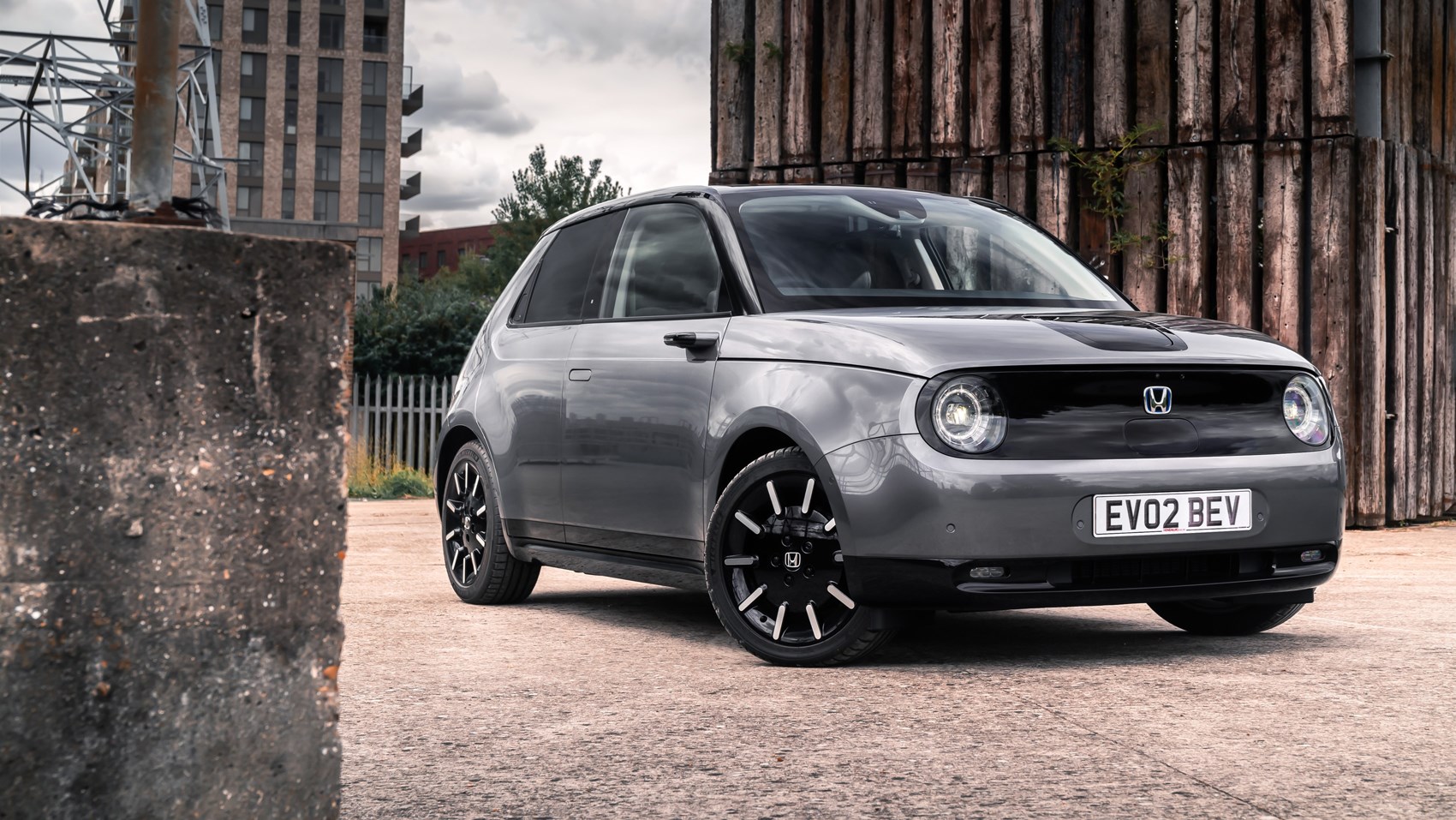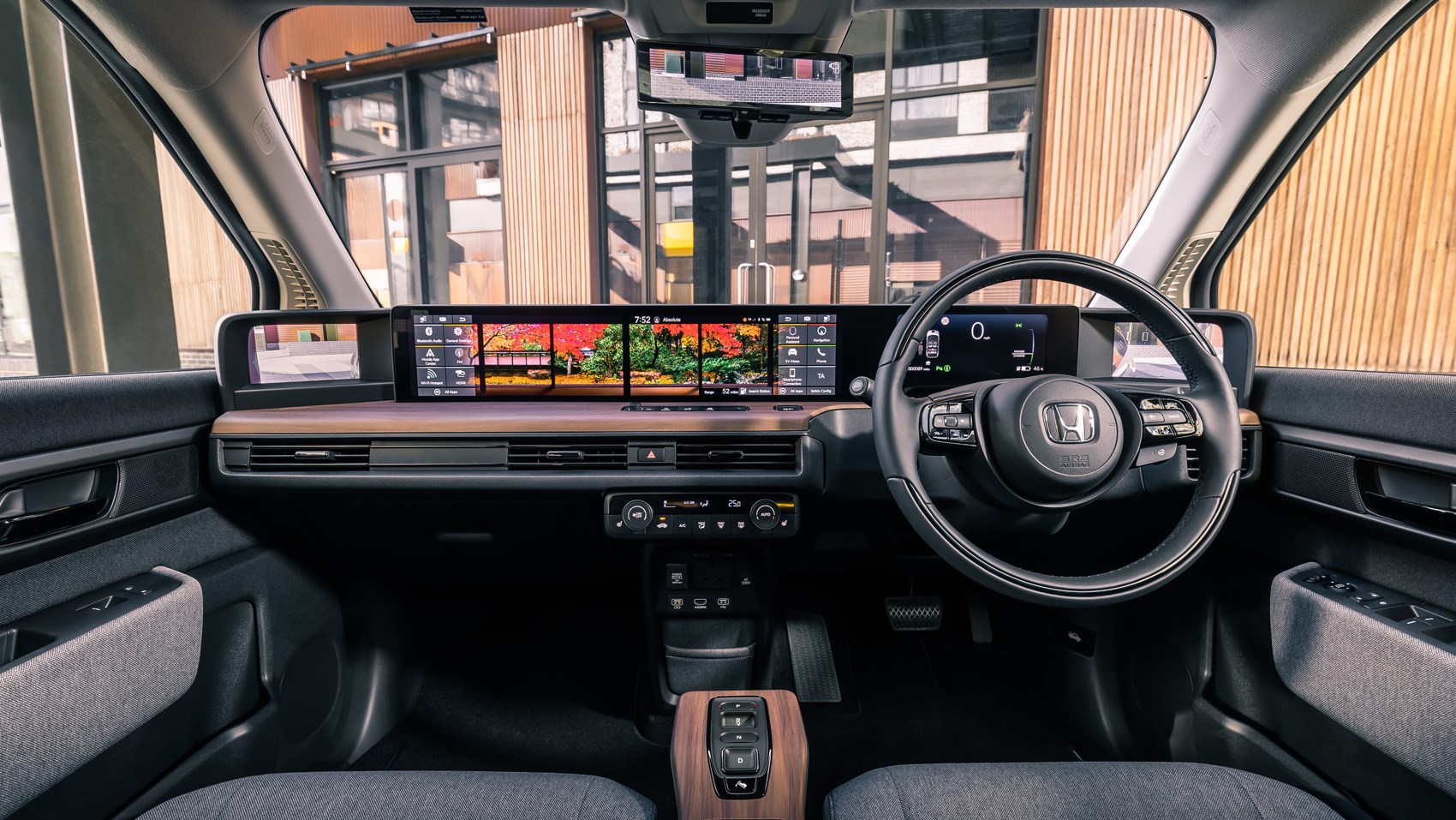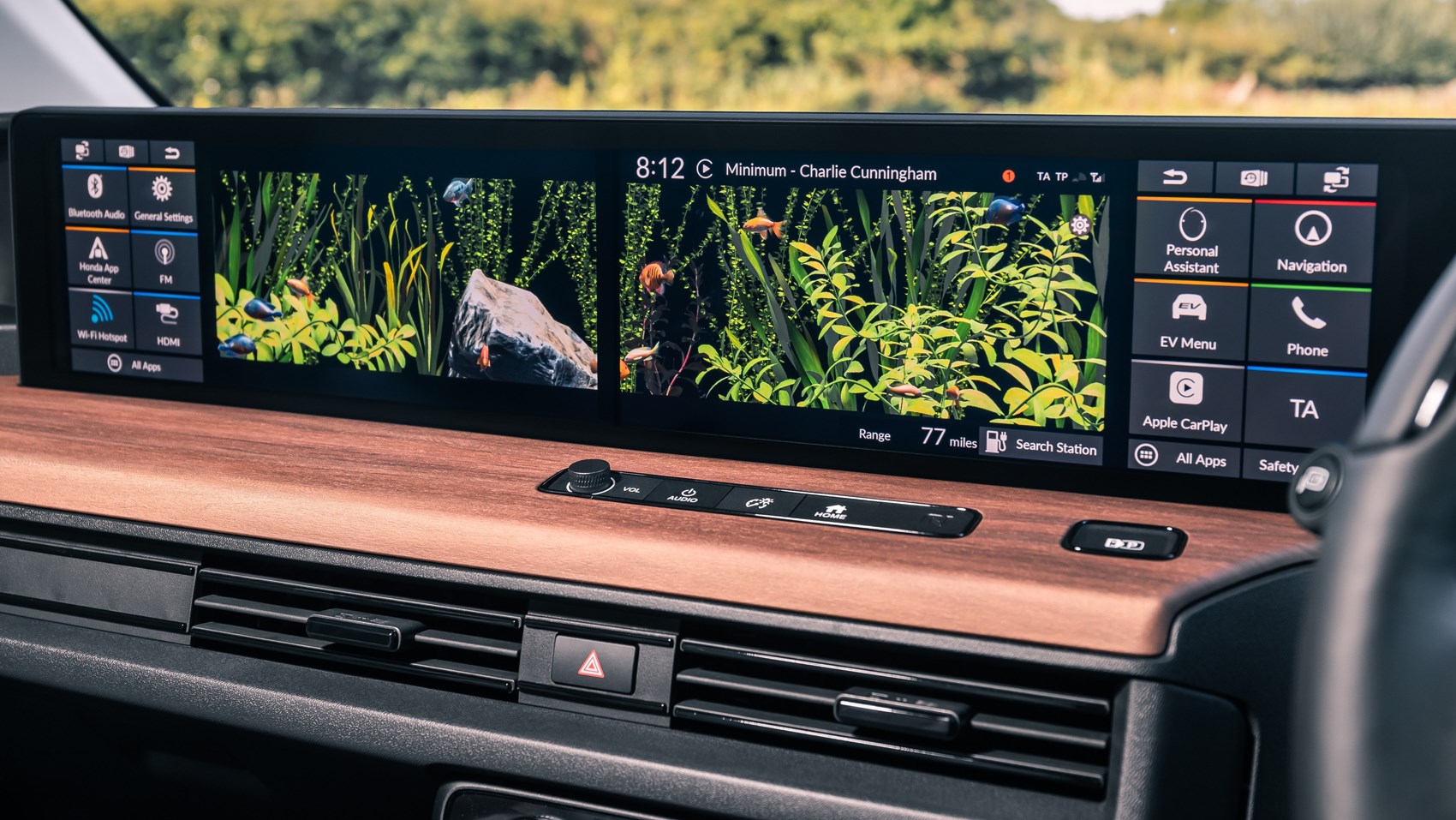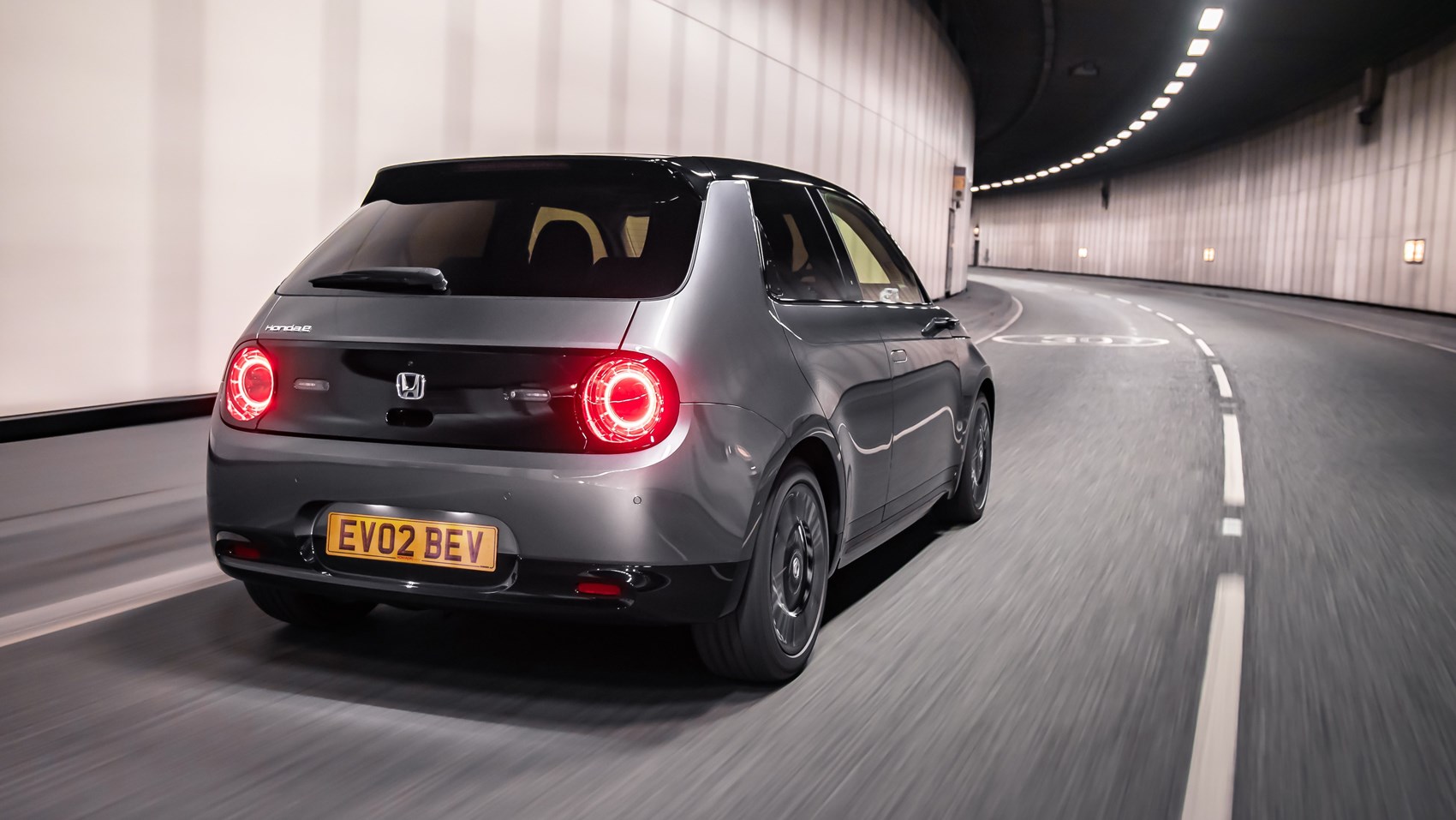► Driving the new Honda E city car
► 125-137-mile range, prices from £26k
► Full Honda E review in the UK
The Honda E is an electric car that's been turning heads and and getting credit cards a-fluttering since it launched: this is one of the most individualistic cars we've seen for years. Packing everything Honda knows about electric cars into one distinctive city car silhouette; you'll notice when you first clap eyes on an E.
It follows on from the original Honda Urban EV concept car, which was shown back in 2017 and, yes, the production version has been watered down a little. It's not quite as slammed as the show car, but to these eyes Honda's done a great job of retaining the cutesy styling that appealed in the first place.
Mini Electric vs Honda E vs Peugeot e-208: the CAR Giant Test
Honda E electric car price - how much does it cost?
As of October 2021, UK prices for the Honda E are:
- Honda E £28,215 (or from £275 per month on finance)
- Honda E Advance £30,715 (or £311 per month on finance)
Yes, that's a lot for a small electric car, when you consider other EV city cars like the Mini Electric and the Renault Zoe. All of these are cheaper and offer longer driving range - Honda E range being limited to 137 miles at very best, and that's according to the official figures - so the little Honda starts life with something of a price handicap.
Best electric cars: the best EVs on sale today
Kohei Hitomi, the Honda E’s Large Project Lead, told us: ‘We hope that the price is not a determining factor – if you’re price-conscious, then maybe an EV in the first place is not the right choice. We are aware that this car is designed for a certain customer profile, but this is our proposal – we believe and hope that people opt for the car because of the design or the features.’
So that's a premium market position then - not unlike the route chosen by BMW with its conceptually similar i3 electric car.
Honda E: what’s under the skin?
A brand spanking new, rear-wheel drive bespoke electric architecture premieres here. The lithium-ion batteries are mounted as low as possible in the floorpan and capacity is rated at 35.5kWh, which is paired to a single electric motor available in two power outputs – 134 or 152bhp (both with 232lb ft of torque). It's enough thrust to guarantee a 0-62mph dash in nine seconds for the less powerful E, and 8.0sec for the more powerful Honda E Advance.
Honda claims a 50:50 weight distribution, and that RWD layout means the turning circle is a taxi-spec, tiny radius of just 4.3m. Bang on for the E’s main remit of nipping around in the city, then.

Honda says owners can achieve 80% battery charge in 30 minutes using a 100kW fast charger via a CCS2 plug, while a home charger from Honda will take a little over four hours. That small battery does have some advantages, but the range is low enough that many owners may feel constrained to city living.
There’s a button for one-pedal driving, much like this Nissan Leaf. Ease off the throttle and the regenerative braking is remarkably strong. If you don’t use this function, you can adjust the ferocity of the regular regenerative braking via paddles on the steering wheel, like in many other EVs and PHEVs.
The Honda E interior is mad, right? What's it like?
Properly swish, and arguably a significant step on in terms of refinement and build quality for the brand. More than anything, though, you can't miss the radical, screen-heavy design.
Honda’s created the interior to promote a feeling of being in a lounge, and the full-width set of screens and wood trim combine nicely with the light grey fabric seats to create a special atmosphere inside. The seats are properly squishy, brown seatbelts are more interesting than black restraints and neat touches like a two-spoke steering wheel and a cupholder that pulls out via a leather strap keep things interesting.

There’s a surprisingly airy feel inside, thanks to those light materials, big windows, standard-fit sunroof and a large flat area between the footwells of the front seats (there’s no transmission tunnel) all combining to good effect. The few switches needed for day-to-day driving (P, R, N, D) are set in a wooden fascia between the front seats - it's decluttered, elegant and really simplifies the driving process without feeling stark. Bravo, Honda.
The main event inside is the that full-width display, plonked on top of the dashboard like a massive flatscreen TV, stretching from door to door. It's extraordinary, a real event. It almost looks like the desktop of a fresh-out-of-the-box laptop, yet is far less intimidating than you’d expect it to be.
In front of you is a small display with all driving functions like any other car with digital dials. It’s crisp and easy to read, but the top of the steering wheel can block it if you like to have it lower down in front of you. Moving along there are two 12.3-inch LCD displays for the infotainment system. It's easy and simple to use, with clear tiles for different functions, and the option to switch screens across. So, you can set the sat-nav on the one nearest to you and then push it over to the screen further away while you fiddle with what you want to listen to via Apple CarPlay or Android Auto. The passenger can fiddle with settings as well, but not to the same degree.

Or, if you don’t want anything going on, you can choose a lovely wallpaper or a moving aquarium to calm the mood when parked up.
The side-view cameras – standard on the Honda E and much more subtle than the Audi E-Tron’s expensive, optional ones – display their view at the bookends of the information display. The positioning might be lower than your average door mirror, but it feels right very quickly; not distracting when you’re not looking but offers a wide view with a smooth and crisp camera feed when you do. They're claimed to halve the rear blindspot, as well as massaging the aerodynamics to further EV range.
However, the central rear-view mirror camera isn't quite as successful; the display feels lower resolution than the door mirrors, to the point that your eyes have to readjust before looking through it each time - and if you drive with spray or rain blocking the view, it’s almost useless. Thankfully you can switch to a regular mirror, so it’s similar to Land Rover’s latest tech found in the Evoque.
How quick is the new 2020 Honda E electric car?
How fast does a city-dwelling electric car need to be? Given it has up to 152bhp and weighs 1.5 tonnes (heavier than a comparable ICE city car) it’s… good enough. The Honda E punches harder than a Renault Zoe from standstill, with the torque curve quickly falling off after 50mph in traditional electric car form.

Honda has added a Sport mode, which remaps the motor to provide max torque a little earlier. It delivers a good punch of acceleration as a result, but you don’t really need it in a little city car. It also sounds like the Starship Enterprise when it drives past, which you'll either find distinctly cool or cumbersome, depending on your outlook (and age!).
Why all electric cars now have to make a noise to alert pedestrians
So how does the Honda E drive?
Let’s get the simple stuff out of the way first. For an EV with its batteries under the floor, the Honda E has an entry height that’s like any other city car and a driving position that does without compromise, unlike the Nissan Leaf, for example. There’s even reach and rake adjustment in the steering column (basics sometimes forgotten on other EVs).
Pedal weighting is definitely pretty ‘normal’, too – the throttle isn’t overly light and the brakes provide smooth progression – something many other electric and hybrid cars can learn a thing or two from. The Single Pedal Control has a smooth application of the brakes when you lift completely off the throttle but, as with all one-pedal driving usage, it’s best just to use it at lower speeds, as it’s quite quick to decelerate at higher speeds. At least the brake lights come on to alert cars behind.
As for the steering, grasping that two-spoke wheel, there’s a reassuring heft at turn-in. Again, it’s not video game-light and hollow, but the E doesn’t corner as eagerly as something like a bantamweight Suzuki Swift or Ford Fiesta (but then it’s really not designed to).

It’s far from completely lifeless to drive like some electric cars at low, obstacle-ridden speeds, but doesn’t exactly hand you excitement on a silver platter, either. What is impressive is that tight turning circle – you’ll be having face-offs with black cabs at The Savoy as to which can do the tightest U-turn. We loved it on our BMW i3 and we love it here. It makes it a fantastic car in town.
There’s hardly any body roll, owing to the Honda E’s low centre of gravity and 50:50 weight distribution. Although we’d like thicker side bolstering on the well-appointed seats for when we’re whizzing around big roundabouts, the lack of head tilt chucking it around some twisty corners certainly didn’t faze the E one bit.
That’s also due to the suspension set-up; it’s a four-corner MacPherson strut configuration, with geometry and damping that’s been benchmarked against larger cars, with testing project lead Takahiro Shinya opining that ‘the i3 or Leaf is not enough for the target setting in terms of vibration or driving comfort.’ Ouch. And it seems to have worked. The e manages to soak up horrid bumps very well indeed. No thumps or vibrations into the cabin, and only the occasional bit of fidgeting depending on the road surface.
Honda E electric car: our verdict
The Honda E is one of the most eye-grabbing electric cars we've yet seen. Its dinky size, cute face and properly cool interior are the biggest draws in its charm arsenal, so much so that some might overlook the low-ish available range and the price higher than other city EVs.
It's a joy to drive, and Honda has hit the bullseye first time out of the box with its first fully electric production car: it handles, rides, steers, stops and goes really sweetly and even turncoat petrolheads will enjoy driving this. It has certainly opened our eyes to how electric cars should drive, even if the range puts us off.
View Honda E electric lease deals
Further electric car reading
Check out our other Honda reviews
Upcoming electric cars
How much does it cost to charge an electric car?